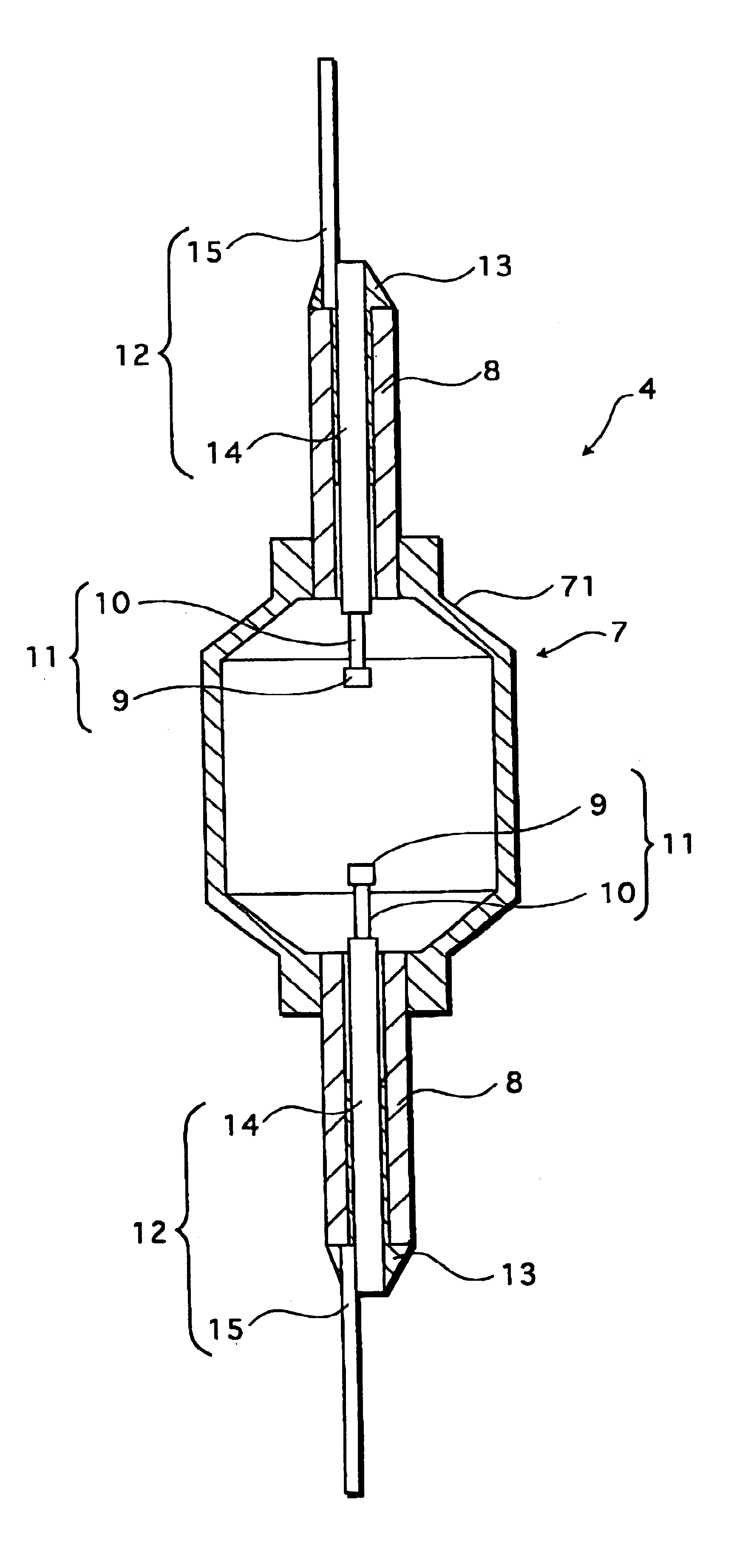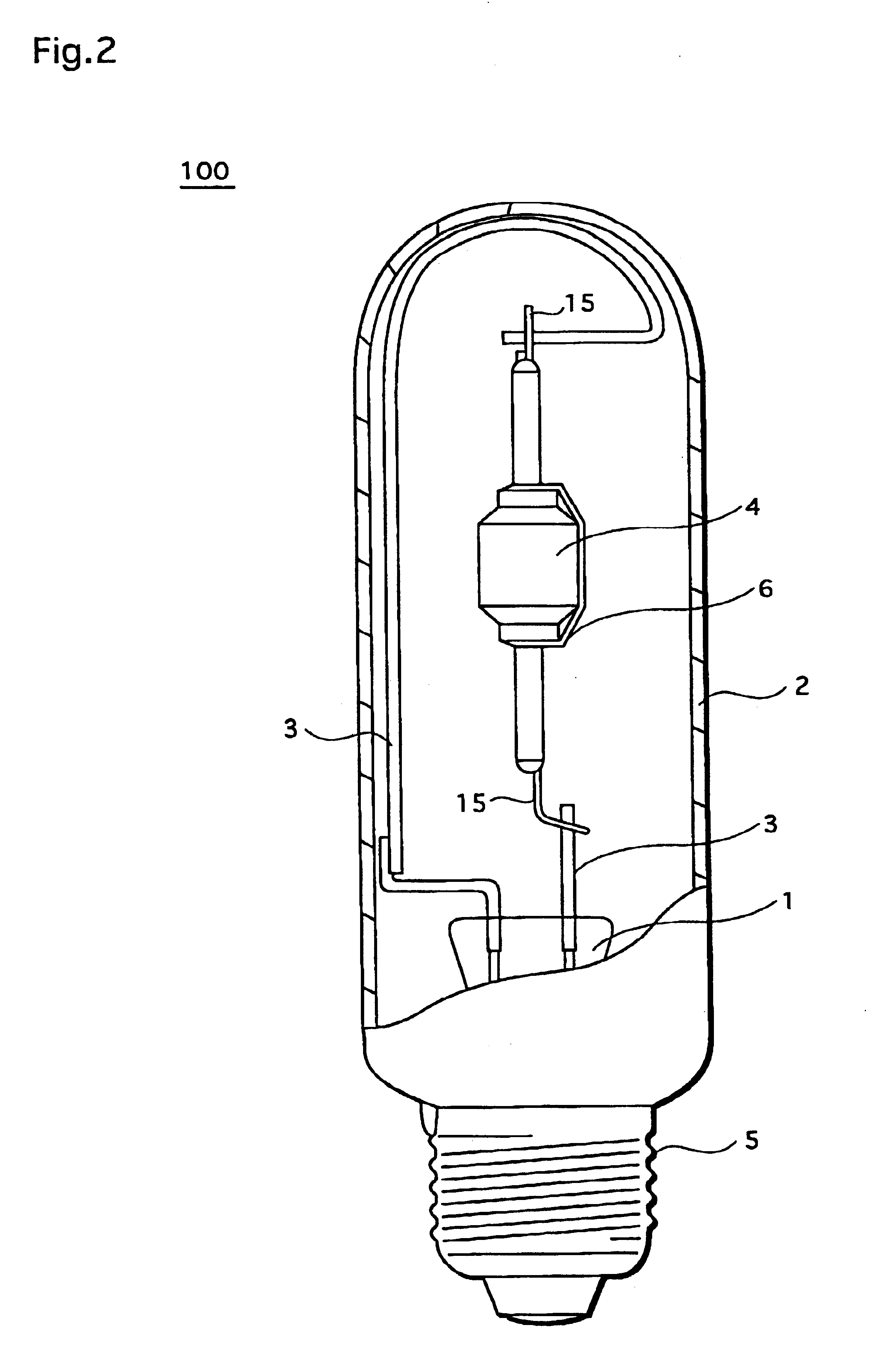High-pressure discharge lamp and arc tube with long operating lifetime and high impact resistance
a high-pressure discharge lamp and arc tube technology, which is applied in the direction of electric discharge tubes, gas discharge lamps details, electrical apparatus, etc., can solve the problems of micro cracks in frit glass, inability to ensure a sufficient lamp life, and corrosion at a brush
- Summary
- Abstract
- Description
- Claims
- Application Information
AI Technical Summary
Benefits of technology
Problems solved by technology
Method used
Image
Examples
first embodiment
(First Embodiment)
The Constructions of an Arc Tube and a Metal Halide Lamp
FIG. 1 is a sectional view showing the construction of an arc tube 4 of a metal halide lamp of the first embodiment.
A vessel containing the arc tube 4, which is an arc vessel, is a ceramic vessel that is made of alumina (whose thermal expansion coefficient is 8.1.times.10.sup.-6), and has a main tube part 71 with an inner volume of 1.1 cm.sup.3, and a pair of cylindrical capillary tube parts 8 arranged at the ends of the main tube part 71.
The emission part 7 of the arc tube 4 includes, inside an internal discharge space of the main tube part 71, a predetermined metal halide and a pair of opposing electrodes 11. In the capillary tube part 8, a first conductive member 14 of a feeder 12 is sealed with a seal member 13.
The feeder 12 has the first conductive member 14 and the second conductive member 15, which are arranged side by side, and the end of the first conductive member 14 and the second conductive member ...
second embodiment
(Second Embodiment)
A metal halide lamp of the second embodiment has the same structure except for a-feeder in the arc tube 4.
FIG. 5 is an enlarged cross-sectional view of a capillary tube part 8 of the arc tube 4 in the second embodiment.
Note that construction elements which are the same as those shown in FIG. 1 are given the same reference numerals, and their explanation is omitted here for the sake of convenience. The rest of the embodiments are described in the same manner.
Referring to FIG. 5, a second conductive member 17 of a feeder 16 is a niobium cylinder that is 20 mm long and has an inner diameter of 0.94 mm. One end of a first conductive member 14 that is protruding from the capillary tube part 8 by about 3 mm is arranged inside a second conductive member 17 and electrically connected to the second conductive member 17 by laser welding, or the like.
In the sealing processing described above, the connecting portion where the first conductive member 14 is connected to the sec...
third embodiment
(Third Embodiment)
FIG. 8 is a cross-section showing the construction of one of the capillary tube parts 8 in the arc tube 4 in a metal halide lamp, which is the third embodiment.
Referring to FIG. 8, a feeder 18 includes a first conductive member 14, with one end inserted into a cylindrical second conductive member 19. The third embodiment differs from the second embodiment in that a fringe 20 is formed at the bottom of the second conductive member 19.
FIG. 9 is a perspective view, with portions broken away, of the second conductive member 19.
Referring to FIG. 9, the fringe 20 is formed at the bottom of the cylindrical second conductive member 19. It is preferable that a diameter of the fringe 20 is smaller than 4.0 mm, which is an outer diameter of the capillary tube part 8, so that a liquid seal member 13, having melted during the sealing processing, is introduced into the upper side of the fringe 20. The example fringe 20 shown here has an outer diameter of 2.5 mm and a thickness o...
PUM
 Login to View More
Login to View More Abstract
Description
Claims
Application Information
 Login to View More
Login to View More - R&D
- Intellectual Property
- Life Sciences
- Materials
- Tech Scout
- Unparalleled Data Quality
- Higher Quality Content
- 60% Fewer Hallucinations
Browse by: Latest US Patents, China's latest patents, Technical Efficacy Thesaurus, Application Domain, Technology Topic, Popular Technical Reports.
© 2025 PatSnap. All rights reserved.Legal|Privacy policy|Modern Slavery Act Transparency Statement|Sitemap|About US| Contact US: help@patsnap.com



